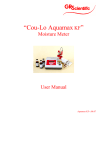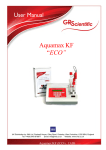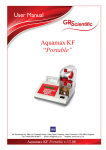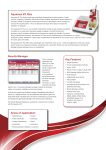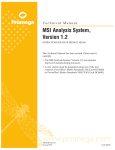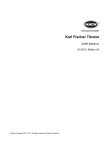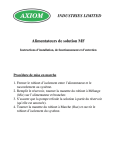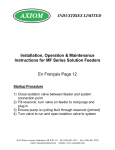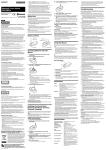Download 74002 b.s.& w. karl fischer titrator manual
Transcript
B S &W Bryant Strawn & Walker Coulometric Karl Fischer Titrator User Manual Technical Support (281) 444 6669 Ordering (918) 583 3109 [email protected] B S & W Portable Karl Fischer Titrator Model BS&W v. 01.06 CONTENTS Introduction …………………………………………………….……… Page 3 Principle of Measurement ……………………………………………… Page 4 Specifications & Features ……………………………………………… Page 5 Unpacking & Parts List ……………………………………………… Page 6 Titration Cell Assembly Instructions ………………..………………… Page 7-8 Filling & Changing Reagents ………………………………………….. Page 9 Front & Rear Panel Description ………..……………………………… Page 10 Setting Time & Date …………………………………………………… Page 11 Connection & Start Up Procedure ……………………………………… Page 12 Programming A Method ……………………………………………….. Page 13-14 Programming Schematic ………………………………………………. Page 15 Example Methods & Applications……………………………………… Liquids …………………………… Crude oils…………………………... Gases ……………………………... Page 16 Page 17 Page 17 Page 18 How To Run A Test………………Example V/SG …………………… Page 19 Printer …………………………… Loading the paper…………………. Page 20 Example Print Out…………………. Page 21 Drift Compensation ……………………………….……………………. Page 22 Overtitration ……………………………………………………………. Page 22 Reagent Life ……………………………………………………………. Page 22 Cleaning the Glassware ………………………………………………… Page 23 Troubleshooting ……………………………………………………….. Page 24 Warranty ……………………………………………………………….. Page 24 2 B S & W Portable Karl Fischer Titrator Bryant, Strawn & Walker STRAWN-BRYANT is a partnership providing measurement and sampling technology for Crude Oil and Natural Gas customers (pipelines, terminals, refineries, producers). The promise to our customer is STRAWN-BRYANT will analyze, design, build, and install a complete solution for measurement and sampling needs producing accurate, certifiable, and repeatable results. Strawn-Bryant integrates new technologies to provide fiscal measurement solutions using automatic sampling, Ultrasonic flow meters, mass flow meters, water-cut analyzers based on Microwave oscillator load pull technology, and a host of other online sampling and analysis technologies for such properties as methanol, sulphur, metals and other elements, as required by our customers. Strawn-Bryant will install, test, calibrate, and certify results based on accumulated sample data. The data gathering is done by proprietary computer programs that will produce data, charts, graphs or any display required by the customer. Strawn-Bryant also provide and insist on complete documentation, training and monitoring the operation until the customer takes total ownership and has established a successful history of the data set as required in the design phase. The award winning product range includes the Model BS&W, offering new standards in versatility and ease of operation. Designed for both Laboratory and Portable applications the Model BS&W is ideally suited to a wide range of applications. The Model BS&W has a small footprint, is easy to use, and is supplied complete with carry case and low drift cell specifically designed for outdoor use. The Model BS&W offers genuine versatility and is ideally suited to crude oil and petroleum products. The specially formulated titration reagents have been specifically designed for use with the BS&W titrators. Formula A anode reagent is suitable for most applications especially for water content determination of oil samples, e.g. transformer oils, crude oils, etc. This anode reagent is supplied in “single shot” bottles of 100ml – No measuring of volumes is required – No mixing of other solvents is required. Cathode reagent Formula C is supplied in “single shot” 5ml vials which have “safety snappers” pre-fitted, thereby reducing risk to the operator. To obtain the full benefits that this instrument can offer, it is recommended that you read the entire user manual before assembling the unit. Cou-Lo is a registered trade mark of G.R. Scientific. “ACE” control system is patented technique owned by G.R. Scientific Ltd. (All Model BS&W power supplies are double insulated units that do not need an earth (ground) connection. These units are sealed and conform to CSA(LR84459), UL listings and CE requirements. BS & W titrators only require a low voltage 15V input to the electronic / control circuitry. The moulded plastc casing of the instrument also provides additional insulation.) 3 B S & W Portable Karl Fischer Titrator PRINCIPLE OF MEASUREMENT Karl Fischer titration is simply a means to measure water content of samples. Modern instruments, such as the Model BS&W, use the coulometric principle, whereby the water present in the sample is coulometrically titrated to a predefined end point at which there is a minute excess of free iodine present. Stoichiometrically, 1 mole of water will react with 1 mole of iodine, so that 1 milligram of water is equivalent to 10⋅71 coulombs of electricity. Combining the coulometric technique with Karl Fischer titration, Model BS&W titrators determine the water content of the sample by measuring the amount of electrolysis current necessary to produce the required iodine. This is an absolute technique which does not require calibration of the reagents. SO2 I2+SO2+3C5H5N+H2O → 2C5H5N.HI+C5H5 N O SO4CH3 SO2 +CH3OH → C5 H5 N C5H5N O H 2I⎯ - 2e → I2 Using the latest pulse current technology and a patented “ACE” control system, the BS&W automatically selects the appropriate titration speed dependent upon the amount of water present in the sample. The titration speed is reduced as the end point is approached, and when the titration is completed the instrument prints out and displays the results. 4 B S & W Portable Karl Fischer Titrator SPECIFICATIONS & FEATURES B S & W Portable Karl Fischer Titrator Titration method Coulometric Karl Fischer Titration Electrolysis control Patented “ACE” control system (GB2370641) End point detection AC polarisation End point indication Visual display / print out / acoustic beep Display 40 character alphanumeric backlit LCD Measuring range 1μg – 10 mg water Moisture range 1 ppm – 100 % water Max. sensitivity 0 • 1μg Max. titration speed 2 mg per minute Max. electrolysis current 400 ma Drift compensation Automatically controlled Start delay time 0 – 20 minutes selectable Power supply 90-264 VAC, 47-63 Hz, 12V DC car adapter/internal battery Precision 10 - 100μg ± 3μg, 100μg – 1 mg ± 5 μg, above 1 mg ± 0•5% Calculation modes Weight/weight (programmable), Volume/density (selectable) Display format μg, mg/kg, ppm, % Print format μg count plus calculated mg/kg, ppm, % water Statistics Preset upto 99 runs Method storage Single method Printer 42 character high speed thermal printer Stirrer speed Microprocessor controlled Battery life 8 hours running time from fully charged Charging time Fully charged 14 hours Battery low indication Display & print out indication Dimensions 10 x 9½ x 5 inches (250 x 245 x 120 mm) Weight 6 pounds (3 kg) Calendar / clock Analysis time & date print out 5 B S & W Portable Karl Fischer Titrator UNPACKING & PARTS LIST Inside the shipping carton you will find a yellow plastic case which contains the glassware and accessories pack and the user manual. The BS&W titrator is located inside the carry case. The mains power lead, power pack and in-car adapter are inside the carry case lid compartment. Remove all of these items and check that they have arrived undamaged. After unpacking your Model BS&W check that the glassware/accessories pack contains:Item Description Low Drift Cell 1 pce Titration Vessel LDC-0102 1 pce Detector electrode LDC-0103 1 pce Generator electrode LDC-0104 1 pce Drying tube LDC-0106 1 pack Injection septa (10) 2000-9507 1 pce Glass syringe 2000-9508 1 pce Luer needle 2000-9509 1 bottle Molecular sieve 2000-9512 1 pce Stirrer bar 2000-9514 1 pce Funnel 2000-9515 1 pce Thermal paper roll LDC-0119 ACCESSORIES 1 pce Mains lead 4014 /20 (US) 1 pce Mains power pack 401607 1 pce In Car Adapter 401421 1 pce Carry case 201109 1 pce User Manual 2000-9517 1 pce Dust cover 301301 6 B S & W Portable Karl Fischer Titrator TITRATION CELL STEP BY STEP ASSEMBLY INSTRUCTIONS Position titration vessel on Cou-Lo titrator The glass joints of the LDC do not require Teflon sleeves or grease. The special screw fittings seal the vessel from ingress of moisture from the atmosphere and are easily released, even after several weeks. Position electrodes on titration vessel. It is not necessary to overtighten these screw joints. Connect leads to generator and detector electrodes. Generator electrode lead connects to socket marked “GENERATOR” – detector electrode lead connects to socket marked “DETECTOR” Place stirrer bar inside titration vessel Fit injection septa into plastic screw cap connectors and locate onto injection ports of titration vessel. Fill drying tube with molecular sieve and locate on top of generator electrode The assembled titration cell is now ready to be charged with reagents prior to use. Please be sure to assemble correctly every time the cell is cleaned or re-filled. It is recommended that the titrator is NOT switched on until after the titration vessel has been charged with reagents. This will avoid damage being caused to the electrodes by the stirrer bar 7 B S & W Portable Karl Fischer Titrator TITRATION CELL 8 B S & W Portable Karl Fischer Titrator FILLING & CHANGING REAGENTS The Model BS&W has been designed to operate with all major coulometric Karl Fischer reagents however; optimum performance can be obtained by using Cou-Lo Formula reagents which have been specifically formulated for use with these instruments. For most routine applications 100ml of Formula “A” (anode reagent) and 5ml of Formula “C” (cathode reagent) should be used. Cou-Lo Formula reagents are especially suited for the analysis of crude oils and other petroleum products as they contain other solvents to improve sample miscibility and solubility. Although reagents can be poured into the titration vessel whilst it is located on the titrator, we recommend that the vessel and electrodes are removed from the instrument whilst this procedure is performed to avoid reagent spillage onto the instrument casing. (Any spillage onto the instrument casing should be wiped off immediately to avoid damage or staining). Remove the drying tube and injection septa. Using the funnel supplied, charge the titration vessel upto the lower line with Formula “A” reagent. For your convenience these reagents are supplied in “single shot” bottles which contain 100ml so it is not necessary to measure any volumes – simply pour in the complete bottle Also using the funnel, charge the inner chamber of the generator electrode with Formula “C” reagent which are supplied in “single shot” 5 ml vials which have “safety snappers” pre-fitted thereby reducing risk to the operator. (It is not necessary to clean the funnel between reagents.) Reconnect the drying tube and injection septa so that the titration vessel is sealed from ingress of atmospheric moisture. Locate the complete titration vessel onto the titrator and connect the electrode leads onto the appropriate sockets Cathode Reagent Anode Reagent The colours of anode and cathode reagent are only an illustration to show that there are two different liquids. These are not necessarily the exact colours of the reagents being used. The Model BS&W titrator is now ready to be switched on. 9 B S & W Portable Karl Fischer Titrator DESCRIPTION Model B S & W Front Panel Press start to activate selected programme, and begin titration The left and right arrow keys are used to move forwards and backwards through the different program menus The up and down arrow keys are used to select different program values and parameters. Press the enter key to store to the memory selected program parameters. Press the program key to access and leave the program menus. B S & W Rear Panel RS232C port for connection to a personal computer Power in socket On / off switch 3.15 Amp 20mm fuse. Unscrew to check and replace fuse 10 B S & W Portable Karl Fischer Titrator SETTING THE DATE AND TIME Switch on the Model BS&W and wait for it to display the following: BS & W Portable Press START Hold down the START key until the BS&W displays:- Set Date / Time: DD/MM/YYYY Use the Use the HH:MM:SS Left / Right keys to move the cursor across the screen. Up / Down keys to increase and decrease the values. After all settings have been entered, hold down the and exit. START key for three seconds to save changes OPERATION The rear panel of the Model BS&W has a mains input socket and a separate power ON/OFF switch. Whilst connected to mains power supply, a trickle charge is continuously applied to the battery. It is therefore recommended that the instrument is used from mains power supply whenever possible so that the battery is kept fully charged. Maximum battery operating time is 8 hours continuous use. This may be reduced if repeated high water contents are being determined or if the printer is being continually used. 11 B S & W Portable Karl Fischer Titrator CONNECTION & START UP PROCEDURE 1. 2. 3. 4. 5. 6. Assemble glassware (see Assembly Instructions) Charge vessel and generator electrode with reagents (see Filling & Changing Reagents) Locate assembled titration vessel onto Model BS&W Connect electrode leads Connect mains lead / power cord Switch ON (using switch on rear panel) and wait for display to show:BS&W Portable Press START (If required adjust the stirrer speed using the black toggle switch on the front of the instrument.) 7. Press START and allow the instrument to precondition (equilibrate). microgram count xxxx μg BS & W Portable |||||||||| detector signal 4 Precondition titration speed battery level / mains indicator At end of the equilibration period the display will show:Dft = xxxxμg ||| Drift Test After the initial drift has been calculated, in micrograms of water per minute, the Model BS&W is ready for operation. Dft = xx || 1 xxxxμg Ready The background drift value will usually slowly decrease with time as the titration vessel becomes drier and more stable. Although it is possible for the titrator to be used at high drift values, it is advisable to wait until the drift value is below 20 μg/minute, and stable, before commencing, especially for low water content samples in the ppm ranges. The lower, and more stable the drift – the more accurate the result. 12 B S & W Portable Karl Fischer Titrator PROGRAMMING A METHOD When the Model BS&W is Ready for operation you can enter titration parameters, by using PROGRAM, ENTER, and the Up/Down, Left/Right keys. Key Functions:Press PROGRAM key to enter and exit the programming menu. PROGRAM ENTER - Allows parameter values from the displayed menu to be entered into memory. This key has multiple functions: - The Left/Right key allows you the move through the different menu options. - The Up/Down keys allow you to scroll through and manipulate the individual parameters in each menu. When required parameter is displayed, press ENTER. MENU LIST Result Format Calculation Mode Start Delay Printer Mode Print Drift RESULT FORMAT Results can be selected in μg, ppm, mg/kg or % water. Display shows:Result format ppm If you want to select this format press ENTER and then carry on moving through the menu using the east/west keys. If you want to change format to give results in μg, mg/kg or % you can scroll through these options by pressing the north/south keys until the required format is displayed, then press ENTER 13 B S & W Portable Karl Fischer Titrator CALCULATION MODE The Model BS&W has two standard calculation modes in memory. Each of these allow the instrument to divide the microgram count by the gram weight of sample introduced so that the calculated result can be printed out in either ppm (mg/kg) or percentage water. Press the north/south keys to scroll through the options available. Select the calculation modes required and press ENTER. The display will prompt you with the appropriate parameters. Enter the numerical value for each parameter using the north/south keys to increase and decrease numbers, and the east/west keys to move along the decimal places. Press ENTER to confirm you choice and return to the main menu. The standard calculations are:1. W/w Result (ppm, mg/kg or %) = microgram count W-w Where W = total weight of sampler + sample (gm) w = tare weight of empty sampler (gm) After entering the total weight (W) the instrument will return to Ready condition. The Tare weight (w) can be entered at any time during the titration, or pressing PROGRAM, or at the end of titration. 2. V/SG Result (ppm, mg/kg or %) = microgram count V x SG Where V = volume of sample (ml) SG = specific gravity/density of sample START DELAY TIME A start delay time can be selected which allows time for the sample to be introduced or dissolved prior to titration current being applied. Options available; 0, 1, 2, 5, 10 & 20 minutes PRINTER MODE Selecting this programme allows the printer to be turned ON or OFF. Options available; Off - no result print out Every result - will print result after every titration PRINT DRIFT Selecting this parameter allows the printing of drift value to be turned ON or OFF. 14 B S & W Portable Karl Fischer Titrator 15 B S & W Portable Karl Fischer Titrator EXAMPLE COULOMETRIC METHODS ASTM D 1533 Water Determination of Electrical Insulating Oils by Coulometric Karl Fischer Titration ASTM D 4928 Water Determination of Crude Oils by Coulometric Karl Fischer Titration ASTM D 6304 Water Determination of Petroleum Products by Coulometric Karl Fischer Titration IP 386 Water Determination of Crude Oils by Coulometric Karl Fischer Titration IP 438 Water Determination of Petroleum Products by Coulometric Karl Fischer Titration IEC 60814 BS EN 60814 Water Determination of Insulating Liquids, Oil Impregnated Pressboard by Coulometric Karl Fischer Titration ISO 10101-3 Water Determination of Natural gas by Coulometric Karl Fischer Titration ISO 10337 Water Determination of Crude Petroleum by Coulometric Karl Fischer Titration ISO 12937 Water Determination of Petroleum Products by Coulometric Karl Fischer Titration 16 B S & W Portable Karl Fischer Titrator EXAMPLE APPLICATIONS LIQUID SAMPLES Liquid samples are usually introduced into the titration vessel by using a syringe. The greater the amount of water introduced into the titration cell will cause the titration to take longer and also consume the reagents more quickly. It is recommended that the smallest representative amount of sample be used to ensure fastest titration speed and maximum sample throughput before reagents have to be replenished. Supplied as standard with every Model BS&W titrator is a 1ml syringe and luer needle. These are suitable for injection of oil samples and water standards. Other volume syringes are commercially available from various suppliers. Please ensure that the needle is long enough to reach into the anode reagent. This guide may be of assistance when selecting injection volume of samples:Expected water content…………….Suggested sample size 1 - 10 ppm……………… 1 or 2 ml 10 - 100 ppm……………… 1 or 2 ml 100 - 500 ppm……………… 0 ⋅ 5 or 1 ml 500 - 1000 ppm……………… 0 ⋅ 5 or 1 ml 0 ⋅ 001 - 0 ⋅ 01 % ……………… 1 or 2 ml 0 ⋅ 01 - 0 ⋅ 1 % ………..…..… 1 or 2 ml 0⋅1 - 0⋅5 % ……………… 0 ⋅ 5 or 1 ml 0⋅5 - 1⋅0 % ……………… 0 ⋅ 5 or 1 ml 1⋅0 - 5⋅0 % ……………… 0 ⋅ 2 ml Above 5⋅0 % ……………… 0 ⋅ 1 ml or less Please note that these volumes are only a guide. You may wish to experiment with sample size to determine the optimum balance between repeatability, reagent depletion and speed of analysis. CRUDE OILS (IP 386 & 438, ASTM D1533, D4928, D6304, API MPMS Chapter 10.9, ISO 10337 & 12937) Most coulometric reagents contain Methanol as the main solvent and as such it is possible that waxy deposits from crude oils can “drop out” and contaminate the electrodes, requiring more frequent and thorough cleaning of the glassware. This problem can be reduced by using Cou-Lo “Formula A” anode reagent which has been specially formulated for this application. The most common interference in crude oil samples is usually caused by mercaptans or sulphides. Samples containing alkyl groups will react stoichiometrically so that: 100 ppm Mercaptans would show as approximately 30 ppm water 100 ppm Sulphides would show as approximately 50 ppm water In normal practice oils containing less than 500 ppm mercaptans or sulphides are regarded as having no appreciable effect. Repeatability problems are usually caused by sampling inaccuracies or improper homogenisation of the sample. 17 B S & W Portable Karl Fischer Titrator GAS SAMPLES Gas samples can be introduced by fitting a needle onto the gas sampling bomb and selecting Calculation mode W/w. Alternatively, gas samples can be bubbled through the titration vessel and the passed volume measured. For this method we suggest using the optional Low Drift Cell (LDC-0101) complete with gas analysis kit (LDC0121). 1. Fit the gas inlet and outlet adapters in place of the injection septa. 2. Remove the drying tube and seal the top of electrode using the injection port septa and screw cap. 3. Connect outlet adapter to wet gas flow meter. 4. Flush the sample lines and allow instrument to stabilise. 5. Press START and allow gas sample to flow through the cell at an approximate flow rate of 0 ⋅ 5 litres/minute. 6. Turn off gas flow and allow titration to reach end point. Calculation G x (273 + t) x 22 ⋅ 4 W= W = moisture content V x 273 x 18 G = microgram count V = gas volume, litres t = water temperature of wet gas flow meter (°C) 18 B S & W Portable Karl Fischer Titrator HOW TO RUN A TEST Please read the section PROGRAMMING A METHOD before running any samples, Example: Program the Model BS&W with required parameters for the analysis. ANALYSIS METHOD 1. Confirm that Model BS&W is in “Ready” mode 2. Flush 1.0ml syringe several times (minimum 6 times) with sample 3. Fit luer needle and flush through with sample 4. Draw sample into syringe beyond the required volume marking 5. Invert syringe so that any air bubbles can be ejected through the needle and adjust syringe plunger to the required volume mark 6. Wipe off excess sample from outside of needle using a clean, dry tissue or paper towel 7. Pierce needle through injection septa of titration vessel (1 – 2 cm) 8. Press START 9. Push needle into anode reagent and inject sample 10. Withdraw needle from titration vessel 11. Read result on display and printout 12. Repeat steps 2 – 11 if duplicate result required 19 B S & W Portable Karl Fischer Titrator LOADING THE PRINTER To load the paper into the printer, first open the paper roll holder lid above the print head and remove the old roll and rollers. Now fit rollers to new paper roll (LDC-0119), load as shown and insert the paper into the slot at the rear of the print head. As soon as the printer sees the paper it will automatically load it. To avoid damage to the printer mechanism it is advisable to only use the correct part number (LDC-0119) thermal paper rolls. Cut the end of the paper roll at a slight angle as shown. This will make it easier to feed into the printer The mechanism has optical sensors which detect the paper and will auto feed. Schematic of paper feed Fit rollers onto both sides of paper roll Locate paper roll in to compartment 20 B S & W Portable Karl Fischer Titrator PRINT-OUTS The Model BS&W allows you to select whether you would like the printer either on or off. If you choose to have the printer on, you will receive a hard copy of the result obtained, together with the selected parameters for that particular titration every time a titration is performed. The Model BS&W automatically increments the next run number every time you press the start button. The run counter is reset to zero when power is switched off and back on again. A duplicate set of results can be printed out simply by holding down the start button for 3 seconds. Results memory is cleared after duplicate print out or when power is switched off. PRINT OUT EXPLANATION B S & W PORTABLE V 2.3v Serial No. 05001 Calibrated DD/MM/YYYY Run Date EXAMPLE OF V/SG CALCULATION Titrator model Software version Titrator serial number Date titrator calibrated Date sample run Run: 1 Run Time Nett Count 0.0 µg Drift 00 Result Format % Calculation Mode V/SG Volume 1.0000 ml Density 1.0000 Run number & time of analysis Nett microgram count (after drift correction) Drift value at start of titration Result format selected Calculation mode selected Sample volume Sample density Res: Calculated result water content 0.0000% Run: 2 Run Time Nett Count 0.0 µg Drift 00 Run number & time of analysis Res: 0.0000% B S & W PORTABLE V 2.3v Serial No. 05001 Calibrated DD/MM/YYYY Run Date Run: 1 Run Time Nett Count 0.0 µg Drift 00 Result Format % Calculation Mode W/w Total Weight 0.0000 gm Tare Weight 0.0000 gm Sample Weight 0.0000 gm Res: Subsequent runs of the same sample and calculation parameters show run number, run time, nett count, Drift value and calculated result. 0.0000% EXAMPLE OF W/w CALCULATION Run number & time of analysis Nett microgram count (after drift correction) Drift value at start of titration Result format selected Calculation mode selected Weight of syringe plus sample Weight of syringe after sample injected Weight of sample analysed Calculated result water content 21 B S & W Portable Karl Fischer Titrator DRIFT RATE COMPENSATION At the start of any titration, the drift value in the top left corner of the screen (in micrograms per minute), is stored in memory. This ensures that the displayed result is corrected for any ingress of atmospheric moisture during the titration period. Whilst in READY condition, the BS&W continually compensates for any drift caused by atmospheric moisture ingress or reagent decomposition and displays this information, which is updated every 10 seconds. If the drift value is above 25 μg /minute the display will show High Drift **XX**. This is a warning that the value is high, however the instrument can still be used by simply pressing START to continue. Provided the drift rate is stable then it usually acceptable to continue operation. The BS&W titration cell design can provide drift values down to less than 5 μg /minute but can also operate at much higher values. The maximum drift value is 60 μg /minute but we recommend operating upto a maximum of 25 whenever possible. If the drift value is above 60 μg per minute the display will read “EXCESS DRIFT - SEE INSTRUCTION MANUAL” Most common causes of excess drift are: Titration vessel not properly sealed (check septa & fittings). Reagents almost depleted (clean & recharge the cell). Sample introduced before pressing START key. Trace moisture on cell walls. If excess drift occurs, switch the instrument off, remove titration cell from clamp, gently swirl the anode reagent around the cell walls, replace cell in clamp, switch instrument on and allow to precondition. OVERTITRATION If the detector electrode senses too much Iodine in the titration cell, usually caused by instrument being left unoperated for a long period, the display will read:“OVERTITRATION - SEE INSTRUCTION MANUAL” Simply add 3-5 microlitres of water, or a small amount of a known wet sample, until the detector signal bars on bottom left of display are activated. Then instrument will automatically carry out its precondition. In extreme cases the pins of the detector electrode may become coated with sample, such as crude oils. In such circumstances it is advisable to remove the detector electrode and clean the pins with a suitable solvent before continuing. REAGENT LIFE There are three main factors which govern the life of reagents, and therefore, the frequency of cleaning and recharging the titration cell: 1. The physical size of the titration cell allows for 50 – 60 mls. of sample to be added. For the analysis of most liquid samples (e.g. solvents) the BS&W normally only requires a few microlitres to be injected, therefore the maximum volume of 50 – 60 mls should not become a limiting factor. 2. The total amount of water that can be analysed before saturation of the reagents varies slightly from one reagent manufacturer to another. Typically a 100 ml charge of Anode reagent (Formula “A”) will analyse upto 1 gm water, whilst a 5 ml charge of Cathode reagent (Formula “C”) will analyse upto 250 mg water. Considering that the injected sample volume is normally small, and also that the analysis is usually for the determination of low levels of water, these water capacity values are not normally a limiting factor. 3. Similar to all other Karl Fischer reagents, coulometric reagents will deteriorate when exposed to sunlight and with increases in temperature. Placing the instrument in direct sunlight or near to a heat duct can decrease the reagent life. As reagents age, the titration speed will reduce and the drift value will increase. 22 B S & W Portable Karl Fischer Titrator CLEANING GLASSWARE IMPORTANT The platinum mesh and wires of the electrodes are fragile and can be easily bent or broken. Extreme care MUST be taken when disassembling, cleaning and reassembling the titration cell. The generator electrode is the most expensive part of the Model BS&W glassware. Coulometric reagents are flammable and toxic, so care should always be taken when handling them and when cleaning the glassware. Whenever possible this should be done in a safe area, e.g. inside a fume cupboard. Reagents should not be recharged while the titration cell is still attached to the titrator. See page 11 on charging procedure. Under normal circumstances the titration cell can be used for a large number of samples before having to replenish the reagents. Once the reagents have been exhausted, or when the titration cell maximum volume has been reached, it should simply be necessary to:1. DISASSEMBLE titration cell 2. EMPTY the titration cell and generator electrode 3. RINSE all parts with methanol 4. DRY all parts 5. REASSEMBLE glassware 6. RECHARGE with fresh reagents If the cell is heavily contaminated then it may be necessary to clean it more thoroughly. For oil samples, cleaning with solvents, for example xylene is suggested; whilst for salt deposits a water wash may be required. Use whichever solvent is most suited for the sample type. The titration vessel can even be cleaned with hot soapy water and a bottle-brush. However, after cleaning with suitable solvent, all glassware parts, MUST be rinsed inside and out with methanol. They can then be dried with a warm air blower, such as a domestic hair dryer, placed in a low temperature oven at 40 – 50 ° C, or left in a desiccator. After being fully dried, reassemble the titration cell and charge with fresh reagents. THE MORE THOROUGHLY THAT THE TITRATION CELL IS CLEANED AND DRIED, THE FASTER THE INSTRUMENT WILL STABILISE READY FOR OPERATION AFTER RECHARGING REAGENTS. Under normal conditions, the Model BS&W should be ready for operation within 5 – 10 minutes after reassembly, however it could take up to 20 minutes before to completely stabilise if the drying procedure has not been properly carried out. 23 B S & W Portable Karl Fischer Titrator TROUBLESHOOTING OVERTITRATION Detector senses too much Iodine. Usually caused by old reagents or stirrer switched off. Check stirrer speed. Add 3-5 microlitres of water until detector bars activate, and allow to precondition. In extreme cases the pins of the detector electrode may become coated with sample, such as crude oils. In such circumstances it is advisable to remove the detector electrode and clean the pins with a suitable solvent before continuing. EXCESS DRIFT Indicates excess moisture ingress or condensation on cell walls. Switch OFF. Remove titration cell from clamp and gently swirl anode reagent around the cell walls. Reconnect, switch ON, and allow to Precondition. LONG PRECONDITIONING TIME Normally caused by glassware not being sufficiently dried before assembly. Re-clean glassware and electrodes, dry thoroughly and charge with fresh reagents. PROGRESSIVELY LOWER RESULTS FOR SAME SAMPLE Moisture contamination of syringe. Flush syringe and needle with sample several times before beginning new test. POOR REPEATABILITY FOR SAME SAMPLE Sample size probably too small or moisture contamination of syringe. Increase sample size and flush syringe and needle several times before beginning new test. WARNING LETTERS ON PRINT OUT Warning letters will be printed after time of each analysis to signify the following:U – Uncalibrated, E – Calibration expired, B – Battery level low, A – ACE system active INSTRUMENT CARE Although the instrument casing is highly resistive to most solvents care should be taken to ensure that any spillage is wiped off immediately to avoid staining or possible damage to the paint surface. TECHNICAL SUPPORT For technical advice and assistance our consultant coulometric KF specialist is available to discuss any questions, problems or applications with you. Simply email [email protected] for a prompt response. WARRANTY Under the conditions of our warranty, all faults which are proved to be due to material, construction or manufacturing defects, which occur within 24 months of the delivery date, will be repaired or replaced, (at our discretion), free of charge at our premises. Freight costs will be chargeable along with any inspection work which was not necessitated by manufacturing or material defects. Breakages of glassware or electrodes are not covered by this guarantee. In the event of instrument failure during the warranty period, written authorisation must be obtained from the manufacturer prior to shipping. 24
























